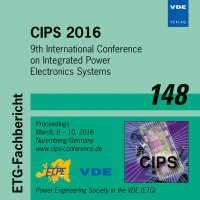400 A, 1200 V SiC power module with 1nH commutation inductance
Conference: CIPS 2016 - 9th International Conference on Integrated Power Electronics Systems
03/08/2016 - 03/10/2016 at Nürnberg, Deutschland
Proceedings: CIPS 2016
Pages: 6Language: englishTyp: PDF
Personal VDE Members are entitled to a 10% discount on this title
Authors:
Beckedahl, Peter (Semikron International GmbH, Germany)
Buetow, Sven; Maul, Andreas; Roeblitz, Martin; Spang, Matthias (Semikron Elektronik GmbH & Co.KG, Germany)
Abstract:
Power module packaging has been challenged by recent SiC chip developments. Today SiC Schottky diodes as well as SiC MOSFET chips with current ratings up to 50 A are commercially available. Several applications like solar, medical, power supply as well as induction heating are asking for high current fast switching SiC MOSFET power modules above 400 A rated current. Heavy paralleling of SiC chips is necessary to achieve these power levels. Two main challenges arise from the design of such a high current power module: First, due to the high switching speed of SiC devices the commutation loop inductance has to be significantly improved to levels below 5 nH. Second, due to SiC chip size limitations many chips have to work in parallel which requires a very symmetrical layout of the power and gate circuit inside the power module. The two layer flex of the SKiN Technology die attachment enables new possibilities of power track routing and chip arrangements in power module design, leading to a significant reduction in commutation inductance. The remaining problem is still the interface to the DC-link. Industry standards require certain clearance and creepage distances which lead to a stray inductance of more than 10 nH only in the busbar interface of traditional power modules. A new SiC MOSFET power module based on SKiN technology is presented, which overcomes the limitations of conventional power modules. The two layer flex which is sintered to the SiC MOSFET is also used to carry the main current to the power interface. With the new construction principle an ultra low inductance path from the DC link capacitor through the module interface down to the SiC chips is possible. Additional snubber capacitors are not required. The half bridge power module with 8 x 50 A SiC MOSFET chips in parallel has a total commutation stray inductance of less than 1.4 nH.


